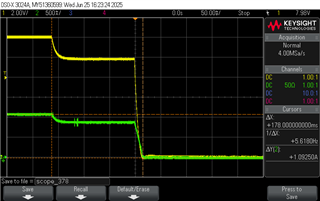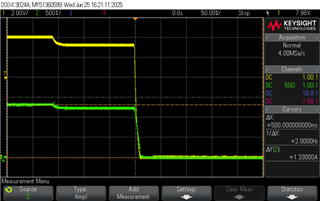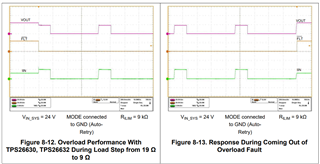Tool/software:
Hi,
During our qualification tests we notice a behavior which we didn't expect.
TPS26632 used at 12V. Trip current set to 0.9A (R_Ilim =20k) and 1.2A (R_Ilim =15k)
We would expect an I_lim error of about 10% (according the datasheet) --> 0.81A-0.99A & 1.08A-1.32A
Test procedure: 12V applied, E-fuse enabled. The load is a settable resistance which is slowly decreased, to increase the current.
During our tests we see that the current trip is at the maximum value (or even a bit over, but that can be due the measurement error) 1.09A & 1.33A We expected a more typical behavior.
After a short delay the fuse start limiting; Voltage is dropping to reduce current. The current limit is then more in line what we would expect 0.9A & 1.2A. (not exactly measured, but seen in the trace as the current drops a bit)
We would have expected an increasing current, until it reached I_lim, and hold at I_lim, until it goes into shutdown. Not an increasing current going over L_lim, and is reduced to I_lim after a while, before it goes into shutdown.
If we repeat the test, and set the load to the current 0.9A and 1.2A, the E-fuse does not trip.


Yellow is the output voltage; Green is the output current
So it seems that there is a difference in trip current, and current limit.
In our situation we are more interested in the actual trip current, than the current limit before shutdown.
Q: Is this normal behavior of the circuit? Can the working of this behavior be explained? Can you provide the calculation for the trip current?
Thanks.


